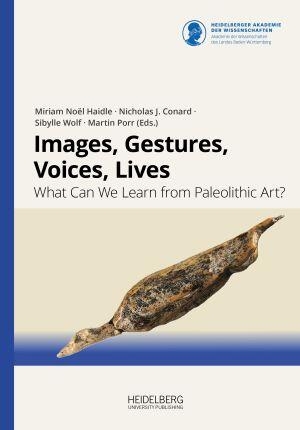News | New Publications | Excavations | Events/Conferences/Workshops

Events/Conferences/Workshops
From October 8 - 10, 2025 the research center ROCEEH is organizing the symposium
Diversifying Networks
How Culture Infuses the Environment
The symposium takes place at Senckenberg Research Institute and Natural History Museum Frankfurt/Main, Germany. For further information and the preliminary program please refer to the first circular.
News
20.8.2025
We are delighted to announce the publication of the book "Images, Gestures, Voices, Lives. What can we learn from Paleolithic Art?", from the ROCEEH Communications series, an open access and print-on-demand publication series edited by the ROCEEH research center. The book is also available in bookstores as a hardcover edition.

The concept of ‘Palaeolithic art’ and its study have changed considerably in recent decades. The modern notion of ‘art’ is cross-culturally and diachronically problematic. The phenomenon cannot be reduced to material visual culture, but also has acoustic, haptic and other dynamic aspects. It must be understood as a variety of processes that can encompass both the everyday and the extraordinary. In this volume, archaeologists, philosophers and anthropologists approach ‘Palaeolithic art’ from different perspectives, including its conceptualisation, aesthetics, relations to art history and art brut. The contributions deal with the challenge of materiality, evolutionary aspects, physical re-enactment by actors, digital technologies as a means of interpreting art objects, and the protection of cultural heritage. The volume offers innovative insights into past practices and contemporary ideas and approaches related to Palaeolithic art, based on careful empirical research combined with reflective and sophisticated theoretical approaches.
Haidle, M.N., Conard, N.J., Wolf, S. & Porr, M. (Hrsg.): Images, Gestures, Voices, Lives. What Can We Learn from Paleolithic Art?, Heidelberg: Heidelberg University Publishing, 2025 (ROCEEH Communications, Band 2). DOI: https://doi.org/10.17885/heiup.1453.
22.07.2025
We congratulate the Faya Paleolandscape on its inscription on the UNESCO World Heritage List! (https://whc.unesco.org/en/list/1735/)
Faya is famous for one of the world’s oldest and most continuous records of early human presence in arid environments over 200,000 years. It yielded evidence for the long-supposed southern route of modern human expansion “out of Africa” via the Bab-al-Mandap strait. The long sequence of occupations of the Faya Paleolandscape indicates that the Arabian Peninsula was not just a corridor, but an independent region of human cultural evolution. Since its early years, ROCEEH has supported research in Jebel Faya and neighboring sites financially and with personnel.
13.06.2025
The 25th newsletter of the "The Role of Culture in Early Expansions of Humans" is now available.
26.3.2025
In the shortfilm series "Aufgepasst! Kulturelles Erbe neu entdeckt" ("Watch out! Cultural heritage rediscovered") by the Heidelberg Academy of Sciences and Humanities, a second episode has been released: In cooperation with the research center ROCEEH, the film "Hightech aus der Höhle!" ("High-tech out of the cave") was realised, which deals with the needle find from Aghitu-3 cave in Armenia. The film can be found (in german only) on Youtube or in the Academy's media library.
New Publications
20.8.2025
Smith, Krister T., Bruch, Angela A. (2025): Persistent greenhouse conditions in Eocene North America point to lower climate sensitivity. Communications Earth & Environment & (1), p. 352. DOI: 10.1038/s43247-025-02288-z.
25.06.2025
Bader, G. D., Sommer, C., Linstädter, J., Masia, D. P., Blessing, M. A., Forrester, B., & MacDonald, B. L. (2025): Decoding hunter-gatherer-knowledge and selective choice of lithic raw materials during the Middle and Later Stone Age in Eswatini. Journal of Archaeological Science, 180, 106302. DOI: 10.1016/j.jas.2025.106302
Hallett, E.Y., Leonardi, M., Cerasoni, J.N., Will, M., Beyer, R., Krapp, M., Kandel, A.W., Manica, A., & Scerri, E.M. (2025): Major expansion in the human niche preceded out of Africa dispersal. Nature (2025). DOI: 10.1038/s41586-025-09154-0
05.06.2025
Christopher S. Beekman, Andrew W. Kandel, Joan Anton Barceló, Rachael Kiddey, Hélène Timpoko Kienon-Kaboré, Corey S. Ragsdale, Kouakou Sylvain Koffi, Gninin Aïcha Touré, Laura Mameli, Jeffrey H. Altschul, Christine Lee, Ibrahima Thiaw (2025): A collaborative synthetic view of migration in archaeology: Addressing challenges for policymakers. Journal of Anthropological Archaeology 78: 101667.
DOI: 10.1016/j.jaa.2025.101667
7.5.2025
Mata-Gonzales, M., Starkovich, B.M., Zeidi, M. & Conard, N.J. (2025): Prey choice and changes in site occupation intensity during the Middle and Upper Paleolithic at Ghar-e Boof (southern Zagros Mountains, Iran). Archaeological and Anthropological Sciences 17:95. DOI: 10.1007/s12520-025-02191-w.
Blanco-Lapaz, A., Luzi, E., Serangeli, J. & Conard, N.J. (2025): The secret of the lake. The role of fish during the Middle Pleistocene at Schöningen (northern Germany). Conference paper: Hugo Obermaier Society for Quaternary Research and Archaeology of the Stone Age, 66th Annual Meeting in Faro, Portugal. ISBN: 978-3-946387-62-6, pp. 27-28.
23.4.2025
Jarl, J., Gasparyan, B., Kandel, A.W., Smith, A., Bruch, A.A. (2025): A high-resolution paleoenvironmental record based on phytoliths from the Armenian Highlands: The Upper Paleolithic of Aghitu-3 Cave. Journal of Archaeological Science: Reports 64, 105148. DOI: 10.1016/j.jasrep.2025.105148.
Hertler, C., van der Geer, A.A.E., Puspaningrum, M.R., Reschke, J.-O., Anwar, I.P. & Hölzchen, E. (2025): Stegodon SEA-crossing: Swim, shrink, and disperse. Earth, History and Biodiversity 4, 100026. DOI: 10.1016/j.hisbio.2025.100026.
Bruch, A.A., Kern, A.K., Stebich, M., Weitzel, N., Bolus, M. (2025): Large-scale vegetation shifts during substantial warming — Proxy-based biome reconstructions of MIS 6 and MIS 5e in Europe. Quaternary Science Reviews 356, 109308. DOI: 10.1016/j.quascirev.2025.109308.
Excavations
The next paleolithic excavations in the Swabian Jura will take place from may 5th until august 29th 2025 in Hohle Fels. Further information you can find here.

